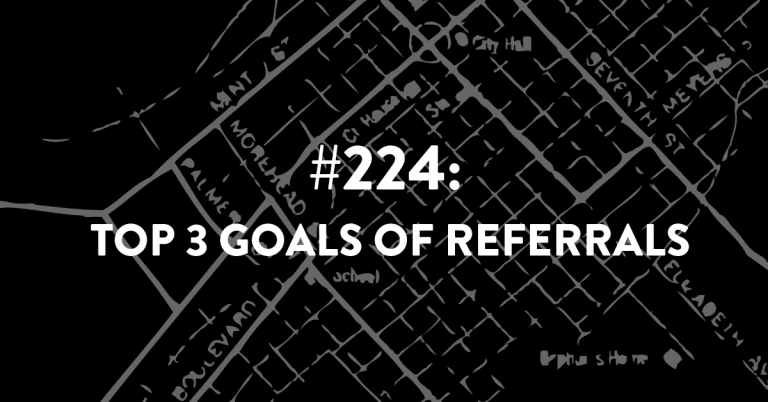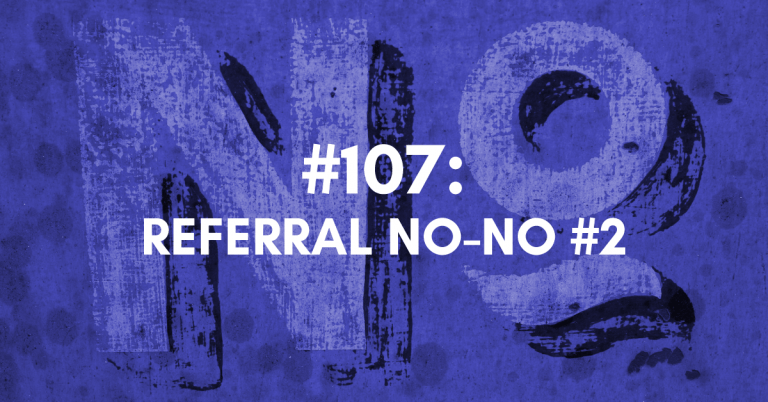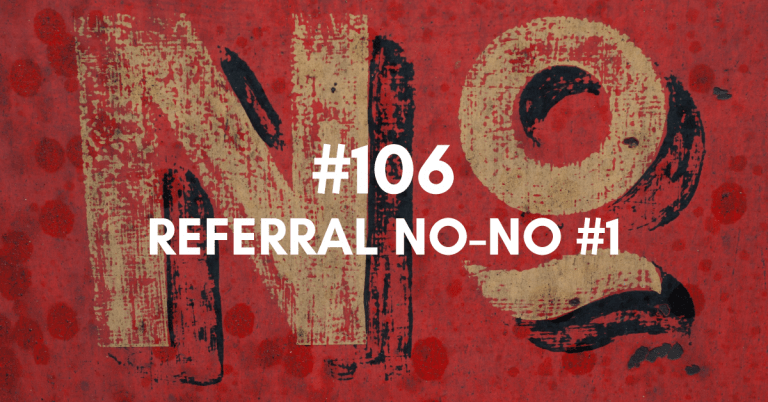Ep #275: Tech Start Up Applications to Improve Referrals
There are different ways to start a business and scale it. Today, we dive into the world of startups and how you can use their strategies to improve your referrals. We discuss three valuable tips typically given to startups, and I’ll show you how to implement them in your own referral process. It’s a unique perspective that will surely enhance your referral game.
But that’s not all. We also take a little detour and draw inspiration from Marie Kondo’s organization process in episode 57. If you’re familiar with her, you know she’s all about sparking joy and decluttering your space. If you haven’t already, check out that episode to learn how to apply her principles to your referral process.
Get ready to double down on your referral sources and watch your business thrive!
Links Mentioned During the Episode:
Episode #057: 6 Ways to Marie Kondo Your Referrals
Submit your application to join us inside Building a Referable Business™ coaching program and attend our live training later this month.
Next Episode:
Next episode is #276, where I’m going to walk you through what I would do if I had no referral sources.
Download The Full Episode Transcript
Read the Transcript Below:
Stacey Brown Randall: The startup community can provide some great tips we can apply to improve your referrals. Let’s dig in to three ways right now.
Hey there, and welcome to episode 275 of the Roadmap to Referrals podcast, a show about helping you build a referable business. I’m your host, Stacey Brown Randall. My journey from a business failure to a successful business now 10 years in, I know generating referrals naturally and consistently has made all the difference. Working with clients around the world, we leverage the science of referrals, protect relationships above all else, and help you build a referable business.
There are different ways to start a business and scale it. There’s the bootstrap method, it’s a personal favorite of mine, the funding route, the spinoff option, the franchise model, and an acquisition option.
There are pros and cons to each. Certainly not a right or wrong, just different ways to get to business ownership or business growth.
One business avenue I’ve always admired from afar is the funding route or the startup world. Building a business by looking for angel investors, seed money, private equity. The model launches many tech-based companies or SaaS, software as a service-based companies, but of course not only those types of companies.
I came across some information that discussed how tech startups in general can get going and get growing. And I reviewed the suggestions, I instantly saw the connection to referrals.
Shocker, I know, that’s just how I roll. Never one to not see how something in another industry can help me teach you about referrals.
Now, I am not talking about a direct application, but taking the tech startup tips and applying those lessons to referrals. Now, this is actually something I have done before on the podcast way, way back. Episode 57, I did an episode called Six Ways to Marie Kondo Your Referral Process. If you are familiar with Marie Kondo, you know she does the sparking joy of your home organization.
So I will link to that episode for any of you guys who want to go listen to how I took Marie Kondo’s organization process and I made it part of your referral process. I will link to that episode in the show notes.
And of course, if you just want to pull it up on your podcast listening app, it is episode 57. But I will link to this in the show notes for this episode. The show notes page for this episode, StaceyBrownRandall.com/275. That’s for episode 275.
And all this talk of Marie Kondo makes me think I need a home edit version of this podcast. OK, I digress. Maybe that’ll be a future episode.
I think it makes it enjoyable, just my personal opinion, to take something not referral related and use the lessons or the principles or the tips to teach you about referrals. I think it just makes for an interesting lesson.
So for this episode, let’s take a look at three tips typically given to startups, and we’re going to apply it to improving our referrals.
Tip number one, network. In the startup world, it really works like typically that networking is going to come from incubators or programs that are built for startups. One example I came across was something called the Tech Star Program. And the Tech Star Program, and lots and lots of programs like it all across our country, they focus on opening doors for their startup members.
They focus on providing those networking or connection opportunities. It’s not the only thing they do, but of course, it’s a big part of what they do. So one of the things I always tell the startups is, hey, you got to network, you got to get into these incubators, you got to understand where these programs are, that kind of are there, that are built to really assist you, and making sure it’s focusing on opening doors, providing networking and connection opportunities.
So let’s talk about that from a referral perspective. So unless you have all of the referral sources, aka the humans who refer you, unless you have all of the referral sources you are ever going to need, and you are never going to lose one, which, by the way, is impossible, you’re gonna need to cultivate new referral sources.
One way to do that is by networking. But networking like a startup is how I want you to think about this. Because when you network like a startup, the environment you put yourself in matters most.
When a startup business and the startup world is in that community, there are actual things that are created for their success, like these incubators and these programs like the Tech Star program. So it’s not networking for the sake of networking. It’s networking with the people that can support them and bringing those resources together.
Now, let’s be honest, that doesn’t really exist in industries outside of the startup community, but it is something for us to consider when we look at our networking like a startup, and that environment you put yourself in matters most. And so the thing I want you to remember here is, for this networking, for you, and you’re thinking about having more people refer you and finding more referral sources to find you, sorry, and finding more referral sources for you to find them, is all about being strategic and smart.
You’ve got to pay attention to where you’re spending your time when it comes to networking to find other people who can and will refer to you.
So it’s not everybody you know. It’s not everybody you’re connected to on LinkedIn. It’s not every networking group, leads group, whatever group you can join. It’s about being really, really strategic about this.
And as I was putting together this episode, that actually prompted what you guys will hear from me next week. I’m going to dig into this point around networking a little bit deeper in our next episode.
Hey, pardon the interruption. How different would 2024 look if you doubled or tripled or quadrupled the referrals you received this year? If you went from 20 referrals in a year to more than 60 next year? Just like one of my coaching members did. What if you could add another $30,000, $75,000 or $100,000 or way more to your bottom-line next year just from referrals?
If you want to learn how, and I mean exactly how we make it happen inside the Building a Referable Business Coaching Program, then plan to join me the first week of October for my live, private, invitation-only training.
To be invited, you need to complete the BRB application at StaceyBrownRandall.com/referable. Once you’re approved, I’ll share with you all the training details. Again, this is a live, private, invitation-only training.
The link again is StaceyBrownRandall.com/referable. All right, now back to the episode.
All right. Let’s talk about tip number two. What is something we can learn from the startup community?
The second thing they talk a lot about in the startup community is cash infusion. All startups are typically looking for a cash infusion to get started or to take their business to the next level, which means they’re looking for angel investors or eventual capitalists.
Now, how this relates to the world of referrals, this is not you looking for cash infusion. But what this does mean, I want you to think about, is the same kind of way a cash infusion works for a startup business, is this is you doubling down on what should be or will become your largest producer of referral sources.
Is it your clients? What do you do? Do you intentionally have a system and a process behind you to cultivate clients into referral sources?
Is it centers of influence? You’ve got to lean in, double down on who should be the largest producer of referral sources for you. And what I mean by this is that are your referral sources more likely to be clients or are they more likely to be centers of influence? Figuring that out is important.
Now, some businesses are a hybrid. You’ve got clients that refer you, and you’ve got centers of influence that refer you. But when you really dig into the data, you can actually see that usually one group is larger than the other group.
I do not want you to abandon any group while you’re doubling down on the other. I just want you to recognize that, hey, if you get the majority of your referrals from clients, so the majority of your clients become referral sources, you need to double down on that. And you need to be very intentional with a system and a process to cultivate those clients into referral sources. This is your version of a cash infusion.
If you’re in a business where you don’t get as many referrals from clients, but you get a lot from centers of influence, I want you to double down on that by first, pay attention to who are those centers of influence.
So for financial advisors, for some, not all, and it really depends in this case. So maybe this is a bad example. But it really depends on the type of client you’re wanting to work with. Because the type of center of influence that’s going to refer to a financial advisor that works with mostly families and individuals versus businesses will look different.
Let’s just say for sake of argument as a financial advisor, you notice that you’re getting a lot of referrals or you’re starting to see more referrals or you’re starting to see good traction with referrals from centers of influence that are estate attorneys. This is something I want you to pay attention to. I don’t mean you want estate attorneys to refer you and they’re not.
When we are applying this tip of a cash infusion, it’s actually looking at what’s working and leaning into it and doubling down on it and being intentional about what we do to cultivate more people like that, referring clients to you. So whether it’s clients or whether it is center of influence.
Like if I look at this from an example from my previous world, when I used to be a productivity and business coach, I actually had a number of referrals from financial advisors that worked with business owners.
So when a financial advisor had a business owner client, and they were having their quarterly, or their twice a year, or their annual meeting with them, and a good financial advisor would talk about lots of things going on in their client’s life, more so than just how are the finances. But they talk about lots of things going on. And with business owner, as their clients, they were talking about, how is business? What is working? What’s keeping you up at night? Like just not because they know they can fix all their problems, but they want to have a good idea of what their client is dealing with.
When that client started talking about the pressure, or the stress, or the I can’t get it all done, or I just feel like I’m not very productive. I just feel like if I had some better processes and systems. I’ve got to get better control over my time. My time management stinks.
When the financial advisor would hear their clients talk about those kind of things, that stuff, they would say, I know exactly who you need to talk to. I know a productivity coach that works with business owners. She’d be great for you.
When I recognized that. That I had financial advisors that were referring clients to me at a larger percentage, I knew I needed to double down and find more financial advisors and cultivate more financial advisors that worked with business owners that could refer to me. And that became a very healthy place within my practice of how I received referrals.
So I don’t mean ignore. Like, I had clients that would refer me. That’s great. I wanted to keep them. I wanted to keep cultivating them. I definitely didn’t stop trying to cultivate clients to become referral sources. But I recognized there’s a volume piece here.
If I pay attention to this type of COI that’s referring to me, and I should lean in, I should double down, I should focus on that because there is the potential there for me to actually generate even more referrals because this person meets my ideal client before I ever meet my ideal client. And that allows me to become a great person for the referral source, the financial advisor, to refer their client to me.
Okay, so on to number three. The third tip we can get from the startup community. It’s probably my favorite. May not be yours, but it’s definitely mine. And that is starting scrappy. That’s right.
In the startup world, this could be launching your software on a platform like AppSumo. If you don’t know what AppSumo is, just go Google it. It’s just something you should know.
But it could be like launching your software in a platform like AppSumo where you like launch it out to the masses for a deeply discounted rate to get early users into your software so you can build up making sure that it works, working through the kinks, getting the reviews, and then of course being able to say how many clients you have as well, right? That number that people talk about like we’ve, you know, helped over a thousand clients or whatever it is.
So you use platforms like AppSumo. It’s getting scrappy. They’re not going to make a ton of money on a platform like AppSumo. They’re going to actually basically be giving their product away. But it allows them to do what they need. They need users, they need reviews, and they need people to tell them when things aren’t working. And so they get scrappy, right?
Or it could also be another version of this within the startup world is crowdsourcing, right? Using crowdsourcing to source your initial investment or early R&D investment, research and development investment that you need, you could crowdsource it.
That is different from deciding to go pull together a pitch deck and go sit in front of investors and try to win some investor contest or try to get in front of investors that will say yes to working with you. You can do any and all of them. But a lot of startups will tell you they had to start scrappy.
How does this apply to the world of referrals? Well, let’s be honest, the application of starting scrappy in the world of referrals is endless. There are so many ways we could use this tip to help us with referrals.
But the most important thing to take from the application of starting scrappy is the first word.
Start.
More specifically, start where you are. First thing in starting Scrappy with referrals is to know what is real inside your business, which means, what is the reality?
A lot of people will tell me, I get referrals, and then when we dig in, I’m like, you have no idea if you’re getting referrals or not. You just think you do because recency bias tells you, you got a referral two weeks ago, and that’s what you remember, and now you’ve projected it out onto how your entire business runs.
The data won’t lie about where you are. I know for some people, data is super sexy, and for others, it is not sexy. The idea of pulling the data is even probably less sexy, but it’s super important. Your data can tell you what is real. And then once we know what is real, then we know where to start.
Because if you want 2024 to look different with referrals than it did this year, you’re probably gonna have to do some things different. Or maybe just be consistent with the things you know you need to do. That is important for you to recognize.
So if we’re applying this third tip from the startup world, start. And start scrappy if you have to. Actually, it’s kind of my favorite way to start anything. Start scrappy, but please just start.
Understand your data, understand where you are, understand where you need to go, and then be able to know, okay, I have 17 people that refer me, mostly inconsistently. I wonder what it would look like if I could put a system in place to take better care of them to use the right language so that they would be more willing to refer me without me having to do the ick asking or compensating or being overly promotional and gimmicky. What would it look like for me to take better care of them?
That is starting. You, recognizing where you are, recognizing, okay, but here’s the gap I need to close, and then doing it, my friend. Do the work. Do the thing. Just start.
Okay, I hope you enjoyed this episode. The resources mentioned in this episode, like the Marie Kondo episode, can be found on the show notes page at StaceyBrownRandall.com/275.
All right, coming up next week is episode 276, and I’m going to walk you through what I would do if I had no referral sources.
Until then, you know what to do, my friend. Take control of your referrals and build a referable business. Bye for now.







